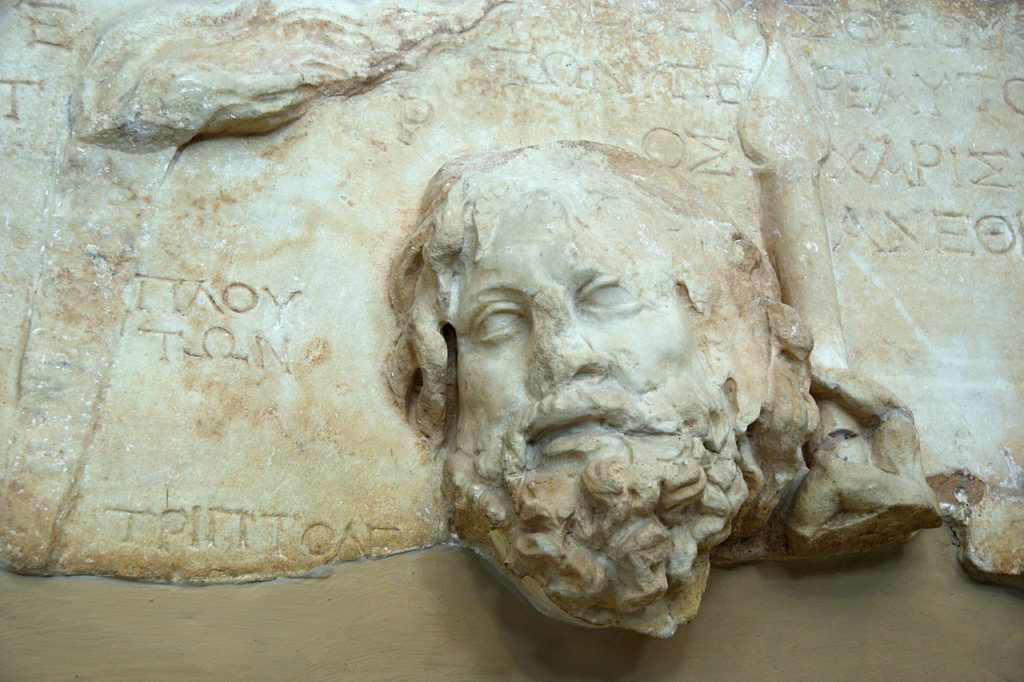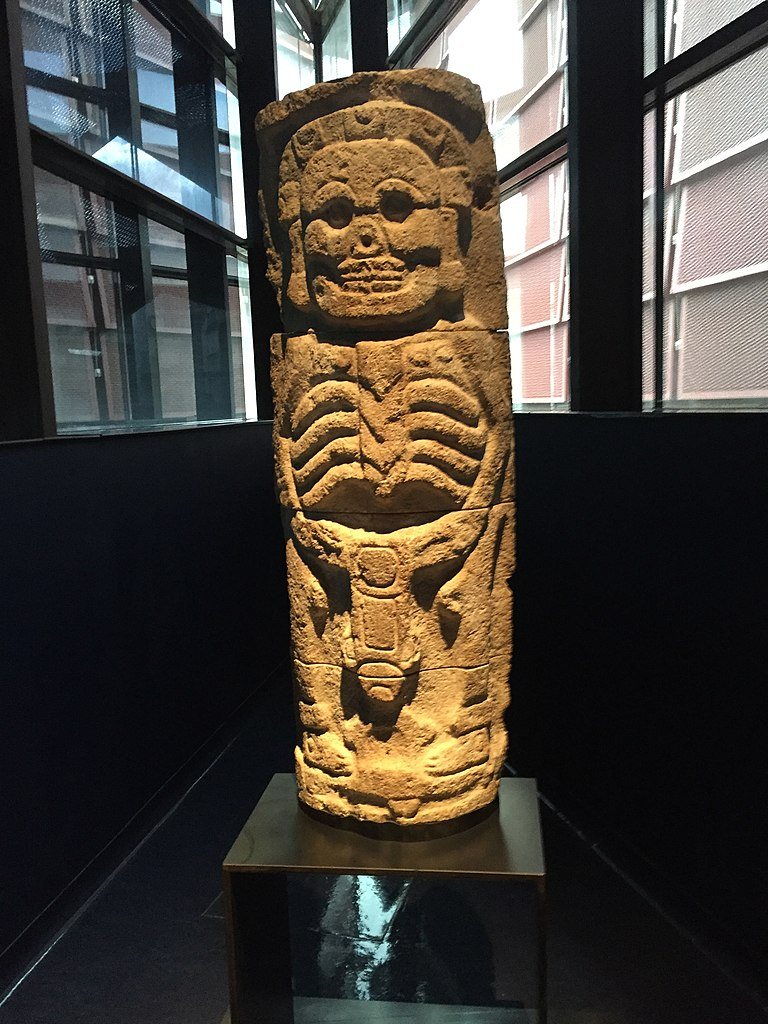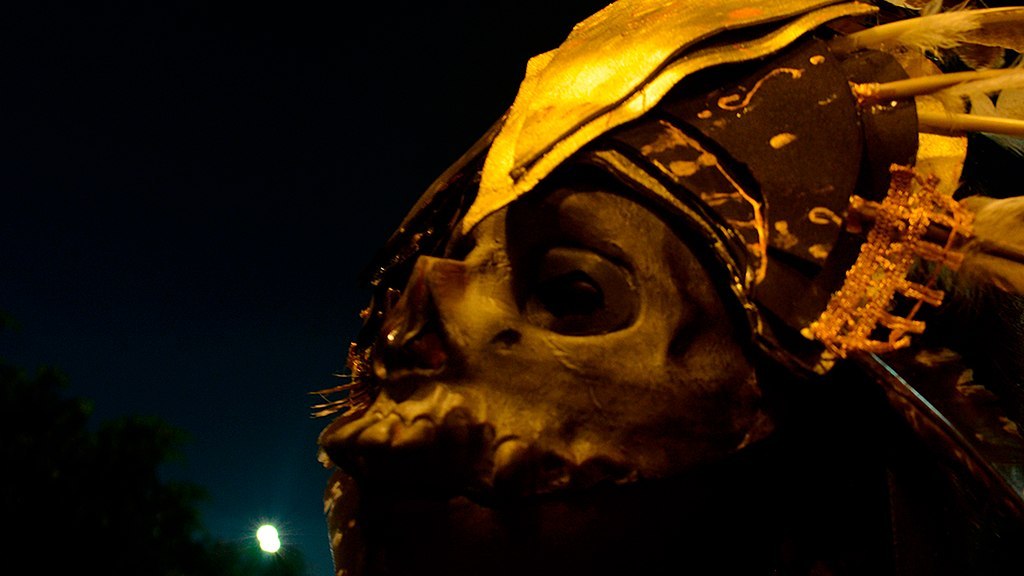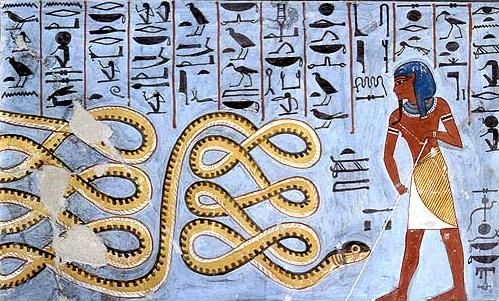Hades, Pluto, and Hel are some of the most well-known gods of death and the underworld from ancient mythology, but nearly all ancient cultures have one. Each death god from around the world represents the unique views different cultures have of death.
Table of Contents
Hades: Greek God of Death

Name: Hades
Religion: Greek Gods and Goddesses
Realms: God of the underworld and death
Family: Full brother of Zeus, the king of Mount Olympus; the firstborn son of Cronus and Rhea
Fun Fact: Hades won his realm after drawing lots with his brothers
As soon as you step inside, the door slams shut behind you and locks itself. Apparently, you’re here for the duration of the gala, like it or not.
That’s not a problem because the evening is shaping up nicely. The decor is wonderfully sinister, but, as it turns out, they never hired a goth decorator. This really just is the underworld of the dead discussed in Greek mythology. You know this because there’s a sign that says, “Welcome to Hades! (Seriously, this is Hades).”
You look around for your goodie bag, but instead, see other humans already regretting their decision. They cluster around this ruler of the underworld — also known as Hades — and plead to be released.
Tough cookies. Hades is famous for being unmoved by the prayers and cries of the mercy of the ancient Greeks. It comes with the job of being the ruler of the dead. If everyone got pardoned, the living world would be overrun by their ancestors in minutes.
READ MORE: Ancient Greece Timeline: Pre-Mycenaean to the Roman Conquest
In Greek mythology, Hades was the first-born son of the Titans Cronus and Rhea. He had three older sisters, Hestia, Demeter, and Hera, as well as a younger brother, Poseidon, all of whom had been swallowed whole by their father as soon as they were born. Zeus was the last born and through the clever antics of their mother, Rhea, he managed to escape his sibling’s fate.
Sitting on his ebony throne, Hades signals for everyone to take a seat. His queen, Persephone, the Greek goddess of vegetation, is next to him. According to Ancient Greek mythology, she was not destined to be an underworld goddess, but when Hades took her into his realm, her mother mourned so badly that summer vanished.
This keeps up, whenever she’s away — the weather always turns wintery in her absence. But though Persephone shares the title of ‘ruler of the underworld’ with Hades, she still visits her family every year.
READ MORE: Hades Helmet: The Cap of Invisibility
Pluto — Roman God of Death

Name: Pluto
Religion: Roman Gods and Goddesses
Realms: God of death and the underworld
Family: Son of Saturn and Ops
Fun Fact: He’s the less sinister Roman version of Hades
The evening kicks off with an award. Another god of the underworld and one of the many ancient Roman deities, Pluto, has been honored for his skill in processing the dead. You’re impressed with his well-oiled approach — first, he meets a boatload of freshly deceased on the banks of the River Styx – The River Styx was a river that formed the boundary between Earth and the Underworld -, then, as each person steps off the vessel, Pluto puts them in chains.
Once the entire batch is ironed up, the death god takes them elsewhere to be judged. This process is kind of like a machine that separates the good eggs from the bad. Those who enjoyed sinful lives are cast into a torturous realm called Tartarus, while the good guys are dropped off in the Elysium Fields where they can be blissful forever.
But just in case anyone gets any ideas, Pluto keeps the gates to the afterlife locked and guarded by a three-headed dog called Cerberus. And he also wears a helmet of invisibility — probably to sneak up on those trying to make a run for it.
READ MORE: Roman Religion
Hel — Norse God of Death

Name: Hel
Religion: Norse mythology
Realms: The Goddess of the underworld; the deity of death
Family: Daughter of the famous trickster god, Loki
Fun Fact: She has terrible siblings, including the most destructive wolf in Norse mythology
READ MORE: Norse Gods and Goddesses: the Deities of Old Norse Mythology
In the tradition of many gods of death, the name of the Norse underworld is identical to its ruler. In this case, it’s a cold-blooded goddess called Hel. Sound familiar? That’s because this deity and her realm might’ve influenced the English word for “Hell.”
While waiting for the next entertainment, the gods of death debate an old problem. Who is Hel? Is she truly a death diety or just a symbol of the grave? It’s a popular discussion but one that goes nowhere — both sides have a point.
While waiting for the next entertainment, the gods of death debate an old problem. Who is Hel? Is she truly a deity of death or just a symbol of the grave? It’s a popular discussion but one that goes nowhere — both sides have a point.
She appears in an important Norse myth, but that’s about it. The sparse number of details is reason to believe that Hel is merely a personification of the tomb and not one of the deities of death in Norse mythology.
The woman is nowhere in sight and no guests have tripped over a grave thus far. Guess we’ll never know.
Kali — Hindu God of Death

Name: Kali
Religion: Hindu Gods and Goddesses
Realms: Death diety, doomsday, time, violence, sexuality, female energy; a mother figure
Family: Married to Shiva
Fun Fact: One of her birth legends describes how she jumped down her husband’s throat, merged with a pool of poison inside him, and emerged as the death goddess Kali
A goddess appears on stage. Unlike Hel, she’s so tangible it’s almost too much to bear.
Kali is a feared warrior in Hindu mythology, but besides her cool moves on the battlefield, she has a terrifying appearance. The audience cheers wildly, though, because Kali is also a paradox — despite the gore draped over her body, this death deity is irresistible to deities and men alike. Nobody seems to care about the bloody knife in her hand, either.
Her fashion show turns you a bit green around the gills. There’s a necklace made of heads; what looks like a tutu is actually a skirt of human arms. For crying out loud, the woman even wears children as earrings!
Her outfit could get her arrested in the real world, but, surprisingly, Kali does have a good side. In mythology, she used her violent nature to save innocents from suffering an ugly death, and on several occasions, she also protected the world against demons.
Anubis — Egyptian God of the Underworld

Name: Anubis
Religion: Ancient Egyptian gods and goddesses
Realms: Mummification, the afterlife, lost souls, the helpless
Family: He’s either the son of Ra (the Egyptian sun god) and Hathor (goddess of the sky), or Osiris (another god of death) and Nephthys (goddess of the sky) — depending on which pantheon of Egyptian mythology you look at
Fun Fact: The Egyptians likely created Anubis after witnessing jackals and dogs dig up graves
Anubis is a striking Egyptian god. His black canine face is one of the most recognizable in mythology. Whether he appears as a whippet-like dog or a man with the head of a jackal, he radiates power and authority.
This pleased the ancient Egyptians who sought all sorts of protection from Anubis. They believed that he could shoo away dangerous wild canines from the living and act as a compassionate guide for dead souls in the underworld.
And Anubis didn’t disappoint — his duties as a god of death were to ensure that the deceased had a proper burial and fair judgment in the afterlife. Plus, he also assisted with their resurrection.
Mythology often describes Anubis acting like a bodyguard for Osiris, and that he was quick to use his physical prowess to put down any attackers. In this sense, he not only oversaw matters related to death, but he was also a god of justice and protection.
To add to all that, he’s the inventor of mummification and the commander of an army of demons. That might explain why there’s a dog in the corner, sending horned creatures between the tables with coupons offering a discount on your next embalming.
Ah Puch — Mayan God of Death

Name: Ah Puch
Religion: Maya mythology
Realms: Metnal, the lowest of the Maya underworlds
Fun Fact: One of several death gods in Mesoamerica, Ah Puch stood out for his cruelty
Of all the death gods at the gala, Anubis hates this creature the most (though Kali loves him because he wears a necklace of eyeballs). Called Ah Puch, you’ve already met him outside as the walking advertisement for the gala.
The two death deities are similar in the sense that they work with human souls. But Ah Puch doesn’t have a fair bone in his decaying, skeletal body. He was blamed in Mesoamerica for death and disease; people feared him because he would target the vulnerable.
But being killed by Ah Puch was just the start. Once he grabbed a human soul, he would burn them until they screamed in agony. And, just to prolong the torture, he would snuff the fire with water before torching them again. This would go on until the soul was completely destroyed. A total death. He sounds like a fun guy.
Mictlantecuhtli — Aztec God of Death

Name: Mictlantecuhtli
Religion: Aztec gods and goddesses
Realms: God of death
Family: Married to Mictecacíhuatl
Fun Fact: He tried to prevent the god Quetzalcoatl from making the first humans
READ MORE: Aztec Religion
A heated argument erupts at the Mesoamerican tables — and it’s not about Hel’s existential crisis.
Mictlantecuhtli is insisting that there’s no paradise for those meandering thingamabobs called “humans.” He’s already angry because he failed to stop the god Quetzalcoatl from making the first Aztecs. Now, all these other gods believing in the heavens and levels of paradise are just ticking him off.
Indeed, the Aztecs themselves never tried the staircase to heaven. There was no such thing for them. They believed that, after death, everyone descended into the underworld. At the end of a four-year journey, their fate was extinction in the ninth and deepest layer called Mictlan.
READ MORE: Aztec Mythology: Important Stories and Characters
Since Mictlantecuhtli ruled this realm, the Aztecs were convinced that they would encounter him personally. Some sucking up was in order, and so he became one of their most important deities.
You regard this god of death with skepticism; that final meeting must’ve been weird. Apart from knowing that Mictlantecuhtli means one’s extinction, he resembles a skeleton. He also wears an eyeball necklace (which is apparently the trendy thing to do), bone earrings, and a hat that looks like a traffic cone.
READ MORE: The Aztec Empire
The Shinigami — Japanese Death Gods

Name: The Shinigami
Religion: Japanese gods and goddesses
Realms: Gods of death and the underworld
Fun Fact: Shinigami spirits only entered Japanese mythology about two or three centuries ago
You experience a fan moment — near the stage is a long table with reapers. As a closet admirer of these swanky and mysterious agents of death, you thought you knew everything about them. But seeing so many together is unexpected.
Most people are only familiar with the lone Grim Reaper. While you’re still wondering about the collective noun for a group of them (a horror, a floating, or maybe a scything of reapers…?), you spot the Reaper between them. And they’re calling him “Dad.”
He refers to them as Shinigami. Well, at least now you know what a group of Japanese soul-rippers is called.
READ MORE: Japanese God of Death Shinigami: The Grim Reaper of Japan
Shinigami is relatively new to Japanese mythology. When the East and West opened to each other, the Grim Reaper’s tale left its mark and the Japanese reapers were born. However, they are very different from him — apart from working in pairs, they don’t have a cloak and scythe, and appear in many guises.
The most obvious difference is how polite these gods are. They don’t abduct souls into the underworld (so ignore the soul-ripper remark), and instead will invite the deceased to cross over voluntarily. Unlike the Grim Reaper, they are not the personification of Death. These gods merely assist the natural cycle of life and death, but they don’t kill anyone.
Read More: The History of Japan
Apophis — Egyptian Death God

Name: Apophis
Religion: Ancient Egyptian mythology
Realms: Death, darkness, thunder, storms, and earthquakes
Family: According to mythology, Apophis already existed before creation or was born at the exact same moment when the world appeared
Fun Fact: The ancient Egyptians actively fought Apophis, using spells and rituals to keep this snake god at bay
The Sun god Ra isn’t invited to this shindig — the gods associated with death have no desire to see deities from the upper crust where there is sunlight and life.
One particular god is bound to make trouble, should Ra stick his toe through the door. Apophis is the Great Serpent and his arch-enemy.
Every night, the death god passes through the underworld where the snake attacks his boat (which is actually the Sun). The ancient Egyptians believed that other gods sailed in the boat with Ra to help slap away the reptile’s coils. Their effort ensured that the barge made it out in one piece — a great moment that was marked by the new dawn each day.
Apophis used to be happy. Before everything was created, there was darkness and chaos. Everything a primordial reptile needs to feel cozy and evil. But with creation, the world filled with sunlight, order, and — ugh, the worst of all — people.
Every night Apophis has a chance to kill Ra and restore his old universe because the death of the Sun is the destruction of all life. This is why Apophis was so feared. In particular, a solar eclipse “showed” that the snake was winning and Egypt went into panic mode. The people believed that they could help Ra win this critical battle and save their world by performing rituals and chants until the Sun reappeared.
Apophis feels abused. Nobody ever loves a snake. He decides to take his frustrations out on you.
Maman Brigette — Haitian and Voodoo Death God
Name: Maman Brigitte
Religion: Haitian and the New Orleans Voodoo religion
Realms: Cemeteries, death, healing, women, fertility, and motherhood
Family: She’s the consort of Baron Samedi
Fun Fact: The goddess is fond of pepper-laced rum, which is often given to her by her followers
Your heart nearly stops as the giant snake slithers towards you. But at the last second, a woman steps in and chops Apophis into several pieces. She tells you not to worry. He’s been hacked apart before and he always comes back to life. It’s a perk of being one of the gods of death.
Then she introduces herself as Maman Brigitte, the goddess of death in the Voodoo religion, and one of the most revered in her pantheon. She’s also the only White-skinned deity there since her roots lie in the Celtic deity Brigid.
She is also known for her salty language when angry, her powerful healing abilities, and as a protector of women. Interestingly, she’s a goddess of death because she ends lives to ease suffering — not to frighten her followers straight.
She is a divine judge, can cure STDs, and infuses clothing with healing powers. This diety, with her red hair and wild outfits, is truly a unique personality. (She’ll also guard tombs in exchange for rum, just so you know.)
Pick Your God of Death
You totally love her now. Maman Brigitte gives out the goodie packs and demonic pets to the guests who are now allowed to go home from the Gods of Death Gala. You pick a thing that’s as floppy as a puppy but is guaranteed by its Kennel union certificate to grow up to look like Godzilla.
The door to the hall unlocks and you walk home with your monster on a leash.
You’re glad to be back on the surface. The grim reality of gods of death is undeniable, but there’s no mistaking the vibrant energy that permeates their legends, realms, and personalities. They almost have more life to them than death. The ultimate irony, if you will.
In all honesty, you attended the gala to get the little monster. But spending time with the darkest jetsetters of mythology was equally satisfying!
My favorite ones are hanes.!!!!!111!!!!!!!!